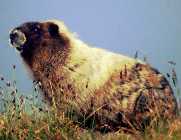 |
 | |
  | |
|
|
|
|
North Cascades National Park Service Complex
Animals
|
|
|
|
|
| |
 |
 |
| The marmot is a common sight in the mountain environment of the North Cascades. |
 |
The North Cascades is one of the most diverse ecosystems on earth. Animals with fins, fur, feathers and scales are all at home in this dramatic and beautiful environment. Elusive mammals like the gray wolf, fisher and wolverine wander the wilderness in small numbers, while more adaptable Columbia black-tailed deer, Douglas squirrels and pikas delight park visitors in abundance. A wide variety of birds breed within the park boundaries, including rare animals such as the bald eagle, osprey, Harlequin duck as well as a variety of neotropical migrants. Fish and amphibians lurk in the clear mountain lakes and streams. The rich forests, rocky slopes and clean waters teem with invertebrate life, such as butterflies, dragonflies, stoneflies and mayflies. Each creature, no matter what its size, plays an intricate role in the North Cascades, whether it is a grizzly bear or a banana slug. North Cascades is home to approximately 75 mammal species in 20 families; around 21 species of reptiles and amphibians representing at least four orders; roughly 200 species of birds in 38 families; at least 28 species of fish; and recent surveys have documented over 500 types of land insects and approximately 250 aquatic invertebrate species.
|
|  |  |
|
|

Butterfly/Climate Change Study
Effects of Forcasted Climate Change on Butterfly-Plant Interaction in North Cascades National Park
more... | |
|
|
|
|
|
|
|
 |
|
Did You Know?
Ancient Forests of the North Cascades have as much biomass as any place on earth. Westside forests are the typical Western Red Cedar and Hemlock forest with old Douglas Firs in open areas altered by man or fire.
more...
|
|
|
|
Last Updated: June 21, 2007 at 18:09 EST |






